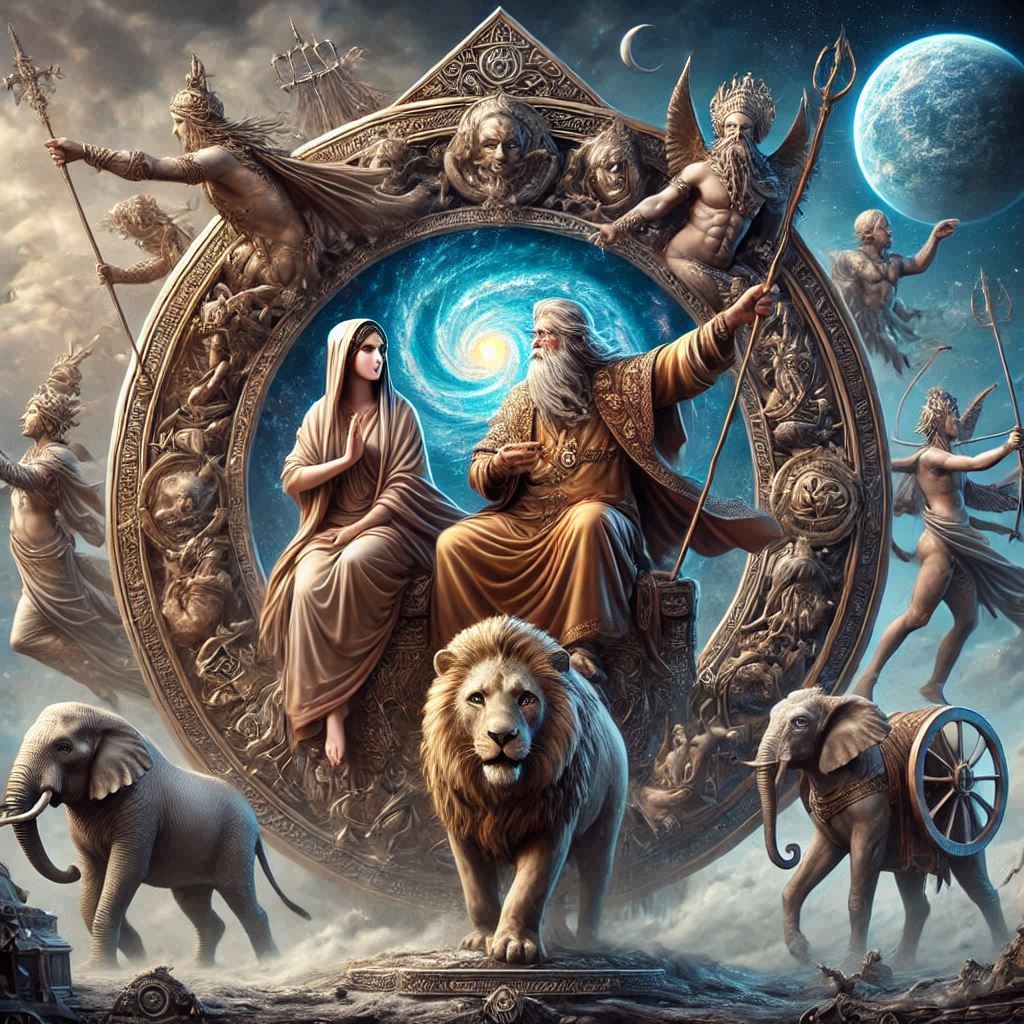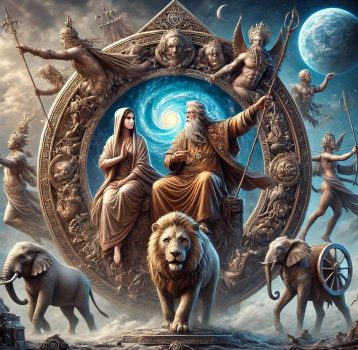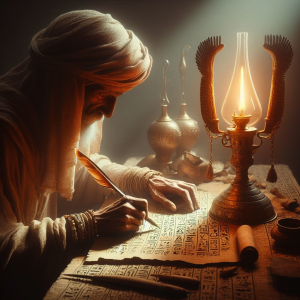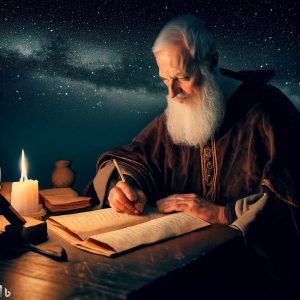
(Previous)…..(Content)…..(Next)
Antiquity and the first manifestations of SF-F
Myths and legends, the seeds of the development of the roots of SF-F
(Romanian)
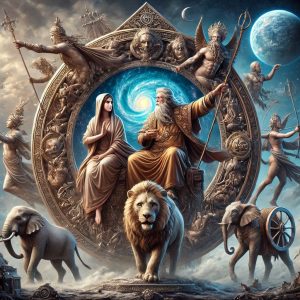
In Antiquity, the idea of the fantastic was born, a kind of seed based on myths and legends that will develop “primarily”, constituting the roots of the future “Science Fiction”. Common roots that “indicate” modern concerns related to space, time, identity, and the meaning of life, which are not unique, but have deep roots in the history of humanity.
It is obvious that many of the “stories” we consider science fiction today have their origins in ancient myths and legends, capturing the imagination of people over the centuries with their wealth of images and symbols, which served as a nursery for many of the ideas and themes that today define the genre (and many of the assimilated subgenres).
Ancient myths, offer a set of archetypal images that continue to influence our subconscious and inspire us in the creation of new stories, to which is added thematic diversity, covering a wide range of themes, from time and space travel, to the creation of artificial life and interaction with other forms of intelligence, will be quite “central” themes of modern “science fiction”.
Stories where the first descriptions of gods “coming from the sky” appear, beings different from humans, often interpreted as being extraterrestrial, or “from another realm”… But, anyway, different from humans, with immense powers, including creators of the human world, of everything that exists available to humanity, starting from nothing or from a primordial chaos (a theme repeated in many future science fiction works)…
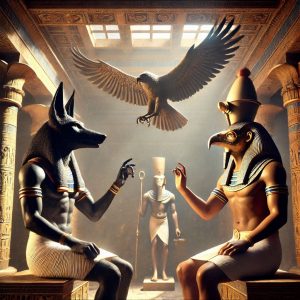
Having a major different “technological availability”, the gods often had “tools” common to them, such as the ability to travel on clouds, or having “fire chariots”, “solar boats”, “vimanas” or other flying devices, etc., clearly assimilable to spaceships (but indescribably perceived by eyewitnesses or imaginative generators).
Beings that seem to exist in some kind of distant worlds where some kind of magical technologies are present that were impossible to achieve based on the availability of humanity at that time, controlling natural elements, curing diseases, offering possibilities for “unimaginable performances”, thus anticipating the concept of advanced technologies.
Which, traveling to other realms, can give rise to the idea of interstellar travel or space exploration, many of the ancient myths are stimulated by journeys to Orion or Sirius, to the Sun or Moon, to Mars or Jupiter, with the help of all kinds of “instruments” of the imagination.
An exploration that attracts not only adventure-type dangers but also major conflicts that endanger beings identifiable as gods, such as battles between gods, assassinations between them, the fight between titans, etc., anticipating confrontations at a cosmic level or, at least, the fight between the different forces of the universe.
Moreover, in some legends, the heroes travel to the past or the future, thus anticipating the theme of time travel…
Then, these beings, whether they are gods, or “something else” (spiritual beings, spirits, nymphs, demons, monsters, etc.) participate in an ensemble that is quite clearly utopian (in the case of ideal “societies” such as Olympus, Valhalla, Heaven, etc., including human utopias such as Atlantis or similar) or dystopian (in the case of Inferno, Hell, blah, blah, and even the “case” of Ragnarok, the end of the world, not to mention the Apocalypse, etc.), being clearly “something else” compared to humans. Or they are placed directly on other celestial bodies… Moon, Sun, Mars, Sirius, Orion, blah, blah…
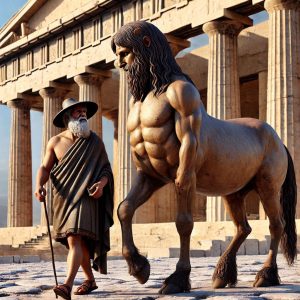
For example, when discussing Egyptian deities, it is obvious that they have an appearance that is different from humans, concerning Seth, Horus, etc. (the examples are quite numerous). Let’s also mention creatures such as Kraken, cyclops, centaurs, sirens, etc., which have constantly fueled people’s imagination with the idea of the existence of beings with unusual shapes and abilities.
Even those who end up being a kind of demigod, having the “genetic touch” of the gods (“sons of the gods”, protected, “tools”, blah, blah), end up having such resources and, thus, adventures and journeys that slightly anticipate the adventures of future space heroes in science fiction.
Thus, we arrive at the transformations and metamorphoses quite common in ancient myths and legends, in which gods or heroes change their form for various interests (including “mimetic” and subversive transformations into animals), anticipating the idea of genetic mutations and bioengineered creations.
To move on to the “tangible” elements that can be used as arguments for the above, although we do not have science fiction novels in the modern sense in antiquity, many ancient texts contain elements that can be interpreted as such. And, here are some of these works…
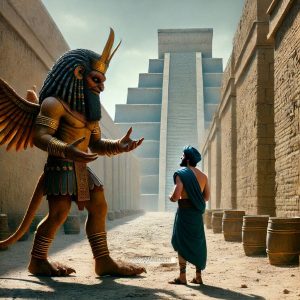
In Mesopotamian mythologies, the “Epic of Gilgamesh” is representative (5 “initial” Sumerian poems that propagate as 5 independent stories that will become an Akkadian epic, the Babylonian “compiled” version being dated somewhere between the 13th – 10th centuries BC).
This Sumerian epic poem, one of the oldest known works of literature, depicts the quest for the immortality of Gilgamesh, a powerful and courageous king. His journeys through underworlds and encounters with supernatural beings anticipate common themes in science fiction, such as the search for the meaning of life, exploration of the unknown, and interaction with other life forms. In addition to the quest for immortality, this epic also describes a universal flood, similar to the Noahic flood in the Bible, a theme of destruction and renewal of the world that is common in post-apocalyptic works.
Relatively “secondary”, the epic is considered a fundamental work in religion and the tradition of heroic sagas, Gilgamesh forming the prototype of later heroes such as Heracles (Hercules) or, from the point of view of “literary works”, serving as a definite influence for the Homeric epic.
And, why not, there would also be “Enuma Elish“, an epic poem describing the creation of the universe from primordial chaos, a theme that has inspired numerous modern cosmic theories, including the Big Bang.
Among the ancient Greeks, we have Homer’s “The Iliad” and “The Odyssey“. These Greek epics contain numerous fantastical elements, such as gods intervening in human affairs, mythical creatures, and magical objects. Then, the journeys of Odysseus, with all his adventures, can be seen as an early form of science fiction, with elements of exploration, encounters with strange beings, and primitive technologies.
Egyptian texts, such as the Egyptian Book of the Dead, contain Egyptian myths about the creation of the world, gods with extraordinary powers, and the afterlife, containing elements that can be interpreted as science fiction. For example, the idea that the soul can survive death and travel to another world anticipates themes related to life after death and the existence of other dimensions.
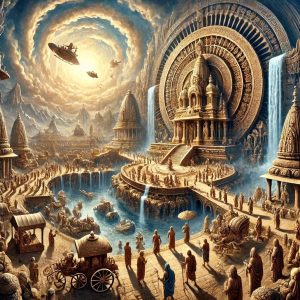
In Indian mythology, we have the Vedas and the Upanishads. In these sacred texts of Hinduism, we find descriptions of multiple worlds, divine beings with cosmic powers, and processes of creation and destruction that are reminiscent of modern concepts of cosmology and physics. Then there are the Vimanas, which, in the Vedic texts, are described as divine flying vehicles. These descriptions have fueled speculation about the existence of advanced technology in India’s distant past.
Not to mention ancient Indian poetry, such as the Hindu epic Ramayana (5th-4th centuries BC), which “reminisces” of Vimana, flying machines capable of traveling in space or underwater and destroying entire cities using advanced weapons.
Or, in the first book of the Rigveda collection of Sanskrit hymns (1700–1100 BCE), there is a description of “mechanical birds” who are seen “leaping swiftly through space with a ship using fire and water… containing twelve stamghas (pillars), a wheel, three machines, 300 pivots, and 60 instruments.”
Or the ancient Hindu mythological epic Mahabharata (8th and 9th centuries BCE), which includes the story of King Kakudmi, who travels to heaven to meet the creator Brahma and is shocked to learn that many eons have passed when he returns to Earth, anticipating the concept of time travel.
In Norse mythology, we have Yggdrasil. This cosmic tree connects the nine worlds of Norse mythology, representing a complex model of the universe. The idea of a cosmic tree is present in many other cultures and has influenced modern concepts of the structure of the cosmos. Ragnarök, which is a prophecy about the end of the world, describes a series of catastrophic events, including cosmic battles and the destruction of the world. Similar themes have been explored in numerous works of science fiction and fantasy.
Mayan mythology has the Popol Vuh. This sacred text describes the creation of humanity and the relationship between gods and humans. The idea that humans were created by gods is a recurring theme in science fiction and fantasy, often associated with themes of genetic engineering and artificial creation.
From here, without citing any “works” (however: Journey to the West, Legends of the Four Great Chinese Classics, “Romance of the Three Kingdoms”, “Water Margin”, “The Tale of Liao Zhai”, etc… more numerous than you can imagine) Chinese mythology comes with Nüwa, the goddess who created humanity and repaired the heavens after a cataclysm. The idea of human creation and repairing a destroyed universe are common theme in science fiction.
Or with Jiangshi, Chinese vampires, reanimated beings who move by rigid jumps, are an example of a fantastic creature that has inspired many horror and science fiction stories. Without forgetting about trips to the moon, in Chinese mythology, there are stories about trips to the moon, thus anticipating the theme of space exploration.
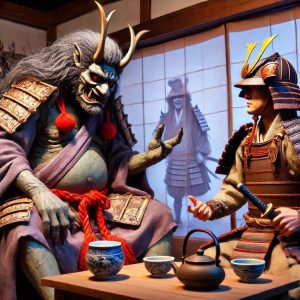
Then, Japanese mythology (including works such as, for example, “The Tale of Genji“, first described in the Nihongi work of 720 AD, which, although not a strictly mythological story, contains numerous supernatural elements and references to Shinto beliefs, following the life of a Japanese prince and his love affairs, in a context rich in symbols and traditions) brings us Yokai, Japanese mythical beings, from forest spirits to sea monsters, offering a variety of fantastic creatures that can be compared to the alien creatures of science fiction, Urashima Taro, a fisherman who is taken to an underwater palace, where time flows more slowly, anticipating the idea of time travel and the existence of underwater civilizations, or Onmyōdō, a Japanese magical practice, which involves the manipulation of cosmic energies, anticipating the idea of technological magic and the human ability to control the natural world.
Or the 10th-century Japanese narrative “The Tale of the Bamboo Cutter,” which can also be considered proto-science fiction, where the story’s protagonist, Kaguya-hime, is a princess from the Moon who is sent to Earth for protection during a celestial war, having been found and raised by a bamboo cutter in Japan. She is later taken back to the Moon by her real alien family.
In this case, a handwritten illustration also appears, depicting a round flying machine similar to a flying saucer… Fantasy or SF (but no science elements appear)?
And Mongolian mythology (including works such as “The Secret of the Golden Mongol“, a legend that describes the story of a hero who travels through different worlds and encounters a variety of mythical creatures, reflecting traditional Mongolian beliefs about the spirit world and the relationship between man and nature) comes with Erlik Khan, the lord of the underworld, a complex figure, often associated with death and rebirth, “building” a theme of the underworld and the cycles of life and death present in many mythologies and explored in numerous works of science fiction, without omitting Mongolian shamanism, which involves journeys into the spirit world, offering a perspective on the relationship between man and the spiritual world, an important theme in many fantasy works.
Should I also mention ancient texts that are a bit harder to “correlate” with myths and legends? Texts are often considered to be examples of science fiction or proto-science fiction with a starting point in fantasy (since there is no “science” in this work)…
One frequently cited text is the 2nd-century satire by the Syrian-Greek writer Lucian of Samosata, a work under the name “True History“, which includes space travel, encounters with extraterrestrial life forms (including the experience of a first-person encounter), interplanetary warfare and planetary imperialism, the motif of gigantism, creatures as products of human technology, worlds that operate according to an alternative set of physical laws, and an explicit desire by the protagonist for exploration and adventure.
Narratively, witnessing an interplanetary battle between the Moon People and the Sun People fighting for the right to colonize the Morning Star, Lucian describes giant space spiders who were “appointed to weave a web in the air between the Moon and the Morning Star, which was done in an instant, and made a simple campaign in which the infantry forces were planted.”
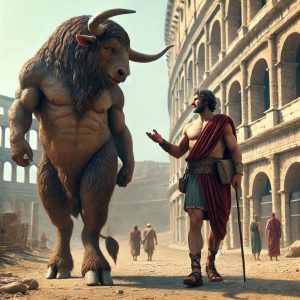
In conclusion, no matter how we approach the “problem”, even starting from the “Old Testament” (Genesis), the “writing” that is “poorest” in fictional elements or assimilable to future science fiction, we have a multitude of other examples, from Nordic mythology to African or Aboriginal folklore that can give rise to the perception of influencing later literature (including SF-F) and, future cinema (or video games).
And, if we proceed to a “technical” analysis regarding the “literary classification in the science fiction subgenres”, even if it seems to be a fascinating and inevitably anachronistic exercise, because these myths were not created to be Science Fiction, we would achieve some surprising results.
Therefore, analyzing them from the perspective of modern SF concepts and tropes (an exercise that highlights the constant human fascination for questions related to origins, powers beyond understanding, future and place in the universe, topics that are central in both ancient myths and in the science modern fiction), we can identify elements that resonate with certain subgenics.
- Proto-science fiction / Fantasy Science: is not an official subgenre, but it best describes works that contain advanced supernatural or technological elements unexplained from a scientific point of view, seen through the eyes of a pre-scientific culture.
And, advancing in “detailing”, the specific fragments, according to the present elements, would be:
The Christian Bible (Old and New Testament):
- Genetic engineering / extraterrestrial (interpretive) creationism: narratives on human creation “in the image and resemblance of” divinity could be interpreted (speculatively) as a form of advanced genetic engineering or as an intervention of powerful extraterrestrial beings (be they energy, supreme, etc.).
- Revelation / post-apocalyptic: The book of Revelation describes catastrophic events on a global scale, followed by a new order, resonating with apocalyptic and post-apocalyptic themes.
- Contact with higher entities/transcendence: Interactions between people and God, angels, or other divine entities can be seen as contact with higher beings, and the promise of eternal life or ascension to heaven suggests transcendence.
- Advanced (interpretive) technology: miracles can be reinterpreted (speculatively) as manifestations of an extremely advanced technology, incomprehensible to people of that time (for example, the cup that gathers mana, the covenant).
The mythology of ancient China:
- Space opera/cosmicism: myths about the gods descending from heaven, wars between the gods affecting the earthly world, and the existence of vast heavenly realms can be seen as incipient forms of opera or cosmicism.
- Genetic engineering/creationism: myths about creating people by goddesses like Nuwa could be interpreted as forms of genetic engineering or creationism.
- Planetary cataclysms: myths about devastating floods or about repairing the sky broken by the goddess resonate with the themes of the cataclysms on a planetary scale.
- Immortality / Transhumanism: the search for the elixir of immortality and the transformation of heroes into immortal beings can be seen as early forms of transhumanism.
The mythology of ancient Greece:
- Space Opera / Extraterrestrial Pantheon: the Olympic gods, with their extraordinary powers and interactions with people, could be interpreted (speculatively) as an advanced alien race that visited the Earth.
- Genetic engineering/hybrids: myths about heroes born of unions between the gods and mortals (Demigods) could be seen as early forms of genetic engineering or hybridization.
- Travel in underground worlds / alternative dimensions: myths about Orpheus descending into Hades or about heroes traveling to other realms can be interpreted as explorations of alternative dimensions or underground worlds.
- Advanced (interpretive) technology: magical objects such as Zeus’s lightning, Poseidon’s trident, or Hermes’s winged sandals could be reinterpreted (speculative) as advanced technological artifacts.
The mythology of Latin America (Aztec, Mayan, Inca):
- Space Opera / Cosmic Gods: myths about the gods coming from the stars, about cosmic cycles of creation and destruction, and links between the terrestrial world and celestial bodies can be seen as incipient forms of space or cosmicism.
- Cyclic cataclysms: Faith in the destruction and periodic recreation of the world resonates with the themes of cyclical cataclysms.
- Contact with higher entities: Interactions between people and gods, rituals, and sacrifices can be interpreted as forms of contact with higher entities.
- Advanced (interpretive) technology: sacred objects or complex rituals could be reinterpreted (speculative) as forms of advanced technology or lost wisdom.

Then, no one can exclude what would be the resulting “dystopic” character of all ancient myths, which, although not in the explicit and structured form of modern SF dystopias (which are often reactions to specific ideologies and systems), resonates with many dystopian concepts, illustrating constant human concerns, control and loss.
We will proceed to a kind of logical determinism that will highlight …
Dystopian elements present in ancient myths:
The order imposed by the higher gods/beings with the price of human freedom or happiness:
- Greek mythology: Zeus/ Jupiter and the other Olympic gods impose a certain order, and their non-observance brings severe punishments. Fate is often seen as an implacable force that limits free will. Prometheus’s myth, punished for providing fire (knowledge/technology), can be interpreted as a warning against exceeding the limits imposed by authority.
- Christian mythology (interpretive): Interpretations of Genesis, especially after the fall of the human being, can be seen as a form of dystopia in which the initial perfection is lost, and humanity is condemned to suffering and death. Divine laws, although meant to guide, can be perceived as restrictive.
- Egyptian mythology: the cosmic order (ma’at) had to be maintained at any cost, and the Pharaoh was the guarantor of this order. Any deviation could lead to chaos and destruction.
Hierarchical and rigid societies with little or no social mobility:
- Many mythologies: caste systems or rigid social hierarchies, often justified by divine origins or the will of the gods, can be seen as forms of social dystopia, where the individual is constrained by their place in society.
The loss of a “golden age” and the degeneration of the world:
- Greek mythology: the myth of the four eras (gold, silver, bronze, iron) describes a progressive degeneration of mankind, from an initial state of happiness and abundance to a world of conflict, suffering, and corruption – a form of temporal dystopia.
- Many mythologies: narratives about an ideally lost past, often due to disobedience or human actions, resonate with the idea of a present or future dystopian state with a lost utopian past.
Information control or suppression of knowledge:
- Prometheus’s myth: The initial fire prohibition for people can be seen as a form of knowledge control.
- Some interpretations of the myths of creation: the prohibitions imposed by the deities (for example, not to eat from a certain tree) can be interpreted as forms of knowledge control or experience.
Periodic catastrophes and constant threat:
- Many mythologies: myths about floods, cosmic fires or other catastrophic events that have destroyed or threatened to destroy the world can be seen as forms of cyclical dystopia or as a world in which stability is illusory.
Finally, it is important to emphasize that these elements do not constitute modern dystopia in the literary sense, ancient myths having other purposes, such as explaining the world, validating social order, transmitting moral and religious values, “dystopian” elements are often side effects of these goals, rather than an intended social or political criticism, as is the case.
And, why not, it is crucial to remember that this “technical” classification is purely speculative and has been made in terms of modern SF concepts, the general character of ancient myths being perceptible as having narrative, religious, social and cultural functions specific to their context and should not be reduced to simple science fiction.
So, from this “minimum” presentation, I think you can perceive the universality, demonstrating that many of our modern concerns, such as the origin of the universe, the search for the meaning of life, the exploration of space, and the interaction with technology, have been present in human thought throughout history, a reality that is amplified by the diversity of manifestation, each culture developing its myths and legends, but all sharing certain universal themes.
This is why they have been and will remain certain themes of inspiration, continuing to inspire writers and artists today (and in the future, even if many current “writings” will become myths), offering an inexhaustible treasure trove of ideas and symbols.
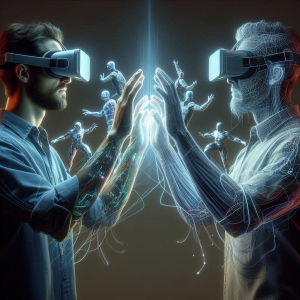
Author’s note: This entire work, done “on the fly”, according to my available time (which will be “completed” more or less by the end of 2025 – based on statistical calculations starting from the 45 episodes already made, at the time I type these lines), is based strictly on the experiences I have gone through, being rarely helped (memory or the desire to organize and offer “additional” informative data strictly related to my perceptions) by additional searches, which I “collect” from the most authoritative sources possible, trying to minimally involve my tastes in those presented.
If you would like additional details, but, obviously, with the specifics of the interpretation of the authors of the respective works (possibly also taking into account “moral excess”), the offer is quite “consistent”, represented for example by:
- “The History of Science Fiction” by Darko Suvin (and subsequent “developments”, including other works with the same “specificity” written by other authors): offers a detailed analysis of the evolution of SF, from its origins to the 20th century.
- “The Cambridge Companion to Science Fiction” edited by Rob Latham (who won the Hugo Award in 2005): an anthology that includes essays from various scholars, exploring different aspects of science fiction.
- “Explorers of the Infinite: Voyages to the Frontiers of Science Fiction” by Adam Roberts (and this author’s “collateral” achievements): presents a history of science fiction through the lives and work of key authors.
Or…
Academic databases:
- Google Scholar: A great tool for finding scientific articles, doctoral theses, and other academic works about the history of science fiction. You can search by authors, titles, keywords, or combinations thereof.
- JSTOR: A digital archive containing millions of articles from academic journals, including many on literature and the humanities.
- Project MUSE: Another platform that provides access to a vast collection of books and academic articles.
Specialized websites:
- The Encyclopedia of Science Fiction: A comprehensive online resource that provides detailed information about authors, works, themes, and subgenres of science fiction.
- Isfdb (The Internet Speculative Fiction Database): An extensive database containing information about authors, works, awards, and events related to speculative literature.
- Locus Magazine: An online and print magazine dedicated to science fiction and fantasy, which frequently publishes articles and essays on the history and evolution of the genre.
Online forums and communities:
- Reddit: Subreddits like r/sciencefiction and r/books offer opportunities to chat with other science fiction enthusiasts and find reading recommendations.
- Specialized forums: There are numerous forums dedicated to SF, where you can find lively discussions about the history of the genre, and classic and contemporary authors.
Blogs and personal websites:
- Many science fiction researchers, writers, and fans maintain personal blogs sharing their knowledge and perspectives on the genre.
- And many, many other resources like this site…
Search tips:
- Use precise keywords: The more precise your keywords are, the more relevant your search results will be. For example, instead of just searching for “history of science fiction,” you could search for “evolution of science fiction in the 20th century,” “women in science fiction,” or “Jules Verne’s influence on science fiction.”
- Explore different languages: Many valuable resources are available in English, but don’t forget to search in other languages, such as French, German, or Spanish.
- Participate in discussions: Join online communities and discuss the history of science fiction. This will help you discover new perspectives and ask questions to experts.
Merticaru Dorin Nicolae
